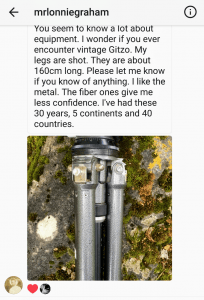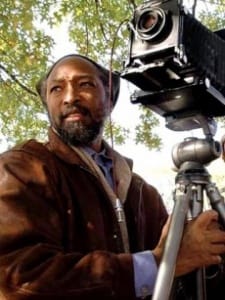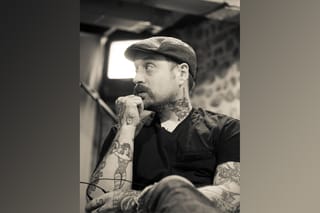
Two attributes I treasure in others are intellect and humility. I can work with one who possesses either; would much rather deal with those who have both, but have no use for those with neither.
Over my many years I have had the opportunity to work with some truly brilliant people and the very best and brightest possessed both traits. Enough preamble. On to the task at hand.
Professor Lonnie Graham possesses both traits. Professor Graham is an immensely accomplished photographer and educator. He is currently an Associate Professor at Pennsylvania State University, and was formerly Acting Associate Director of the Fabric Workshop and Museum in Philadelphia Pennsylvania. He served as Director of Photography at Manchester Craftsmen’s Guild in Pittsburgh, Pennsylvania, an urban arts organization dedicated to arts and education for at risk youth where he developed innovative pilot projects merging Arts and Academics, which were ultimately cited by, then, First Lady Hillary Clinton as a National Model for Arts Education. Professor Graham also served as instructor of special projects and oral historian for the Original Barnes Foundation in Merion Pennsylvania. In 1986 Prof. Graham authored a project entitled, “A Conversation with the World” which has been commissioned in various iterations in several countries around the world.
A couple of years ago my long simmering interest in photography, since childhood, intensified and I began devouring everything I could find on blogs and You Tube. All served a purpose, but few things remain in my memory (admittedly I do have a compromised attention span) long after viewing. This video below has stuck with me since my first viewing. I have shared it with many since. Contained within is an excellent example of the humanity, in Arts and Humanities on display:
Art as Tradition in Modern Culture: Lonnie Graham at TEDxPSU
It is criminal to me that of this posting there are less than 2,000 views.
But it does not stop there. After viewing this I read all I could find online about Professor Graham and it is an understatement to say that his experience and credentials are impressive. I will not attempt to catalog it all here since that would fill multiple blog posts. Instead, I point you to his Penn State School of Visual Arts bio page.
After posting my analog; digital shenanigans and following Professor Graham’s Selection of Images from ‘A Conversation With The World‘ and on Instagram (do yourself a favor and follow him) , I receive this message one day:

I give you exhibit A of Mr. Lonnie Graham’s awesomeness. Intelligence and humility personified. Here were my next steps:
- Reread 5 times.
- Close gaping jaw.
- Google ‘Gitzo tripod legs’.
Not only is he one of the nicest people I have ever encountered on social media…ever, but what followed was the most pleasant exchange. When I recently asked if I could interview him for my first blog post with KEH Camera, he graciously agreed immediately and has been nothing but kind with his time in the creation of this interview. I sign off here and leave you with the interview text. Enjoy!
 Photo source: https://sova.psu.edu/profile/lonniegraham
Photo source: https://sova.psu.edu/profile/lonniegraham
[ELW]– When did you know that photography would be your career focus?
[LG] – Photography as a career focus did not come until Art School. It was 1959 when my Uncle Floyd brought home a Polaroid Land Camera and that was when my love of photography began. It was magic! That brown gelatin, varnish smell, and the gushy mess were magical and I was entranced. The whole ritual mesmerized me. My friend 2-¼” camera was amazing to me.
Then in Junior High School I won a photography contest for $100. That was rent money at that time. That is when I realized that I was on to something. I use to visit the Cleveland Museum of Art often. I would stop and press my face to the glass looking at the contact sheets. After seeing this pesky little black kid looking at these contact sheets so often they finally took me in back to see the whole process. A 4×5 contact print was the most beautiful thing in the world to me. At one point I had thought I was going to be a painter.
Then in Art School I saw a friend’s photography work and I thought that makes more sense. Painting has been around so long, but Photography is relatively new by comparison, so I went with photography over painting. I felt that there was so much that had not been expressed yet through photography. So much untapped potential. But with painting so many greats had come already. 60 years later I am still at it.
[ELW]– What person would you count as your personal inspiration?
[LG]–Cleveland. As mentioned earlier on Uncle Floyd was an early supporter, but my whole family, including my father and many others supported me. They supported everything this nerdy kid wanted to do. They bought Encyclopedias and generally did all they could to support me. They never said no. Later on my Art teacher, Mrs. Monhe, was very supportive.
Then I was able to go to school in Nova Scotia, Canada where I encountered immense influences like Robert Frank. (In 1976 he studied fine art photography and drawing at the Nova Scotia College of Art and Design in Halifax, Nova Scotia where he attended private sessions with photographer Robert Frank… -Wikipedia)
During my time at the Art Institute of San Francisco I met so many influential Photographers like Jack Fulton and Larry Sultan. Imogen Cunningham even lived just up the street.
Ansel Adams would stop in and he was at my graduation where I took a picture with him. Hank Wessel and I are friends still to this day.
In the years since I have been influenced by people like Deb Willis, Carrie Mae Weems, Anne Collier, and recently since the time of my TEDx talk Charles Anderson. He helped me understand that art was more about people seeing it and less about the individual who created it.
[ELW]– What are your thoughts on the current state of social media as it pertains to photography?
[LG]– This is exactly what early photographers had in mind. These early photographers were really interested in everyone having a camera and now everyone does. We are now all networked together. And we share our images as a matter of course, as a ritual, and habit.
The level of introspection occurring ritualistically is stunning. It is my hope that at some point all of this introspection will help people become more circumspect about their own place in the world. How they frame and form their world visually.
I am an eternal optimist. I believe in the power of what pictures can do. Photography transcends language. I am friends with people on social media who do not speak English, but we can communicate through images. While cameras are much more common in this age of smartphones not everyone in the world has access to a picture phone. When I go into these remote places and make pictures for those who would normally not have access they begin to understand how they can advance their message, their cause with images. I have traveled all over the world from New Orleans, to Korea, to Asia, to the Continent of Africa and on and on and I see how people are beginning to understand how it is possible to get their message out using images.
[ELW]– Given the current state of affairs in the US and abroad do you believe photography can have an impact?
[LG]– Yes, I do.
[ELW]– When we talked earlier I shared with you that this interview would be posted on KEH’s Spotlight Blog and you mentioned that you recommend KEH to your students. Could you share some reasons why?
[LG]– Just the other day we had a lively class discussion about what equipment to get and how much to spend. For me it comes down to this question: How much money do you have? I do not need to know what it is. Got it? Whatever that number is double it.
Students then often tell me that they do not have that amount right now. If you get the cheap equipment you will just be replacing it soon once you realize you should have purchased better equipment. If you stretch and buy the better equipment now you will have gear you can use for years to come. That is when I tell them that you do not need to buy the very latest gear and I recommend buying used. I regularly point them to KEH [Camera]. My reasons are:
- Great equipment selection.
- Excellent return policy.
- You can also sell your equipment back once past the return window.
- I like that the rating system is so accurate:
- When rated Like New it comes in perfect condition with box and everything.
- When they say Ugly, they mean ugly. Looks like it was beat with an ugly stick.
I have done business with KEH for a long time.
[ELW]– How has and how does photography help you in life?
[LG]– Nowadays its meditative. It forces me to look at the world, assess, and then see how I can contribute. A tool for interaction and introspection.
[ELW]– What is your favorite camera?
[LG]– Whatever is the right tool for the right job. One of the first cameras I loved was a medium format Yashica. From there I moved on to Hasselblad. I also like to use H&W control film.
That Hasselblad holds a special place with me. A group and I was once being chased by pirates in Mombasa. We fled into the Hills and during the chaos I dropped my Hasselblad in the rocks and mud. Later I left it off with a local guy, a watchmaker working in a tin and cardboard shack for repair and went to get a coke and samosas with our group. When I returned he had fixed the camera with the tools he had available. He then fussed at me for not taking care of this camera. He described it as a magnificent machine.
For portability I shoot with 35mm Nikon cameras as well as an all aluminum 4×5 Toyo field camera that I bought in 1989 and still have. Need to get the bellows replaced.
Gitzo tripod. Love that tripod so much that I had it rebuilt. It has traveled the world with me. (30 years, 5 continents, and 40 countries in fact as noted above).
[ELW]– What gear do you use most often?
[LG]– Recently Nikon D3X. Waiting for them to come out with a larger MP sensor before I upgrade. For lenses I am working on the big three. I have the 12-24mm f/2.8 Nikon, the 24-70mm f/2.8 Nikon and saving up for and need the 70-200mm f/2.8 Nikon.
[ELW]– What advice would you give to an aspiring photographer?
[LG]– I believe that more important than just image making is that they should take an active role in allowing their images to transcend the current state of affairs. What we try to deal with in photography is addressing larger humanity. As we focus more on others we will then be better able to see our own humanity.
Seek a common cause through the course of our common humanity.
Photography creates a window on life where we can see ourselves and others better.




